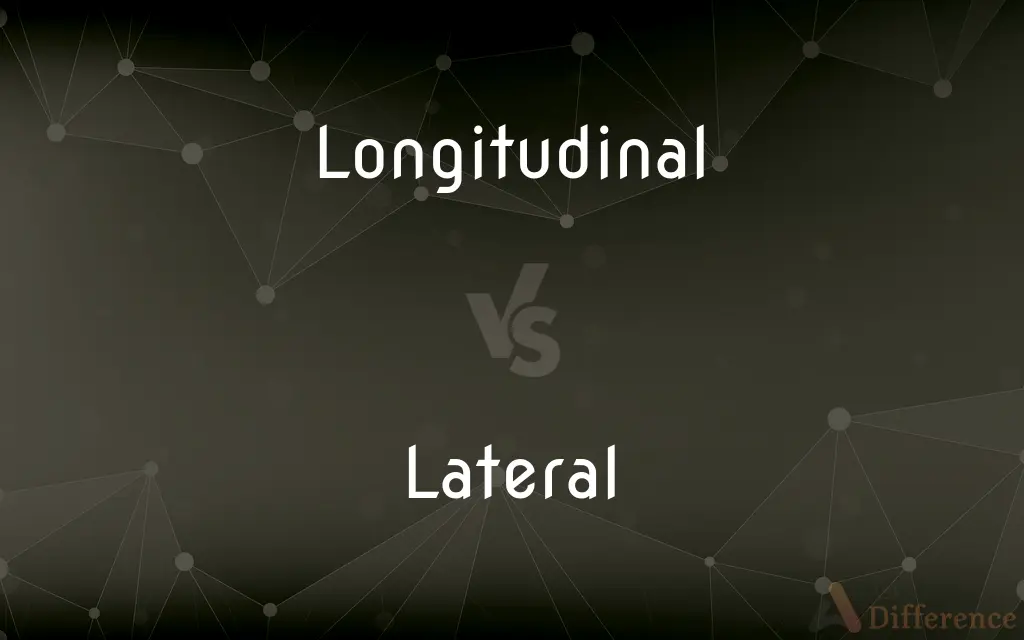Longitudinal vs. Lateral — What's the Difference?
By Tayyaba Rehman — Updated on October 20, 2023
Longitudinal refers to the lengthwise direction, while Lateral pertains to the side or widthwise orientation.

Difference Between Longitudinal and Lateral
Table of Contents
ADVERTISEMENT
Key Differences
Longitudinal and Lateral are terms that describe directions or orientations, often used in various fields like anatomy, engineering, and geography. Longitudinal generally pertains to something running lengthwise, along the longest dimension. On the other hand, Lateral typically refers to the side or something running widthwise.
In anatomy, when one talks about Longitudinal sections, they're referring to sections that run along the length of an organ or body part. Conversely, Lateral views or sections would provide a side view, focusing on the width aspect.
In engineering, Longitudinal forces or stresses act along the length of an object, such as a beam. Lateral forces, meanwhile, push or pull the object side-to-side, often challenging the object's ability to resist bending or toppling.
In geography, Longitudinal lines, also known as meridians, run from the North Pole to the South Pole. In contrast, Lateral might not be the term directly used, but it can be analogous to latitudinal lines, which run parallel to the Equator, side to side across the Earth.
While both Longitudinal and Lateral describe directions, their primary distinction lies in the orientation they refer to: lengthwise versus widthwise or side-to-side.
ADVERTISEMENT
Comparison Chart
Orientation
Lengthwise
Side or widthwise
Anatomical Reference
Along the length of an organ
Side view of an organ
Engineering Context
Forces acting along the length
Forces acting side-to-side
Geographical Reference
Lines running from North to South pole
Analogous to lines running parallel to the Equator
General Description
Pertains to the longest dimension
Pertains to the width or side
Compare with Definitions
Longitudinal
Relating to length or the longest dimension.
The bridge has a longitudinal crack that needs repairing.
Lateral
Moving or directed side-to-side.
The crab has a lateral walk.
Longitudinal
Oriented along the major axis.
A longitudinal study spans several years.
Lateral
Positioned on the side or each side.
There's a lateral extension to the house.
Longitudinal
Running from the front to the back.
The road has longitudinal markings to indicate lanes.
Lateral
Concerning width or breadth.
The lateral expanse of the field is impressive.
Longitudinal
Extending in a straight line.
A train moves in a longitudinal direction on its tracks.
Lateral
Of, relating to, or situated at or on the side.
Longitudinal
Parallel to the direction of growth or main axis.
The tree's longitudinal grain is quite prominent.
Lateral
Of or constituting a change within an organization or hierarchy to a position at a similar level, as in salary or responsibility, to the one being left
Made a lateral move within the company.
Longitudinal
Of or relating to longitude or length
A longitudinal reckoning by the navigator.
Made longitudinal measurements of the hull.
Lateral
(Linguistics) Of, relating to, or being a sound produced by breath passing along one or both sides of the tongue.
Longitudinal
Concerned with the development of persons or groups over time
A longitudinal study of twins.
Lateral
A lateral part, projection, passage, or appendage.
Longitudinal
Placed or running lengthwise
Longitudinal stripes.
Lateral
(Football) A lateral pass.
Longitudinal
Relating to length, or to longitude.
Lateral
(Linguistics) A lateral sound, such as (l).
Longitudinal
Running in the direction of the long axis of a body.
Lateral
To execute a lateral pass.
Longitudinal
Forward and/or backward, relative to some defined direction.
Lateral
To pass (the ball) sideways or backward.
Longitudinal
Sampling data over time rather than merely once.
Longitudinal studies
Lateral
To the side; of or pertaining to the side.
Instead of a promotion, I opted for a lateral move to a similar position in the marketing department.
Longitudinal
Any longitudinal piece, as in shipbuilding etc.
Lateral
Situated on one side or other of the body or of an organ, especially in the region furthest from the median plane.
The medial side of the knee faces the other knee, while the outer side of the knee is lateral.
A fish senses changes in hydrodynamic pressure with its lateral line.
Longitudinal
(rail transport) A railway sleeper lying parallel with the rail.
Lateral
(disease) Affecting the side or sides of the body, or confined to one side of the body.
Longitudinal
Of or pertaining to longitude or length; as, longitudinal distance.
Lateral
(physics) Acting or placed at right angles to a line of motion or strain.
Longitudinal
Extending in length; in the direction of the length; running lengthwise, as distinguished from transverse; as, the longitudinal diameter of a body.
Lateral
(UK) Non-linear or unconventional, as in, lateral thinking.
Longitudinal
A railway sleeper lying parallel with the rail.
Lateral
Pertaining to speech sounds generated by partially blocking the egress of the airstream with the tongue, leaving space on one or both sides of the occlusion for air passage.
Longitudinal
Of or relating to lines of longitude;
Longitudinal reckoning by the navigator
Lateral
An object, such as a passage or a protrusion, that is situated on the side of something else.
Longitudinal
Running lengthwise;
A thin longitudinal strip
Longitudinal measurements of the hull
Lateral
(linguistics) A sound produced through lateral pronunciation (such as /l/ in lateral).
Longitudinal
Over an extended time;
A longitudinal study of twins
Lateral
(American football) A lateral pass.
Lateral
(business) An employee hired for a position at the same organizational level or salary as their previous position.
Lateral
To move (oneself or something) in a lateral direction.
Lateral
(American football) To execute a lateral pass.
Lateral
Of or pertaining to the sides; as, the lateral walls of a house; the lateral branches of a tree.
Lateral
Lying at, or extending toward, the side; away from the mesial plane; external; - opposed to mesial.
Lateral
Directed to the side; as, a lateral view of a thing.
Lateral
A short pass to a receiver who is upfield from the passer, i.e. is behind the passer relative to the direction of the passer's goal.
Lateral
A part or extension of something that points sideways, as a drift in a mine that goes to the side from the main one.
Lateral
To pass the footbal to a receiver who is behind the passer; to make a lateral pass; as, the ball was lateraled to the fullback, who ran it for a touchdown.
Lateral
A pass to a receiver upfield from the passer
Lateral
Situated at or extending to the side;
The lateral branches of a tree
Shot out sidelong boughs
Lateral
Lying away from the median and sagittal plane of a body;
Lateral lemniscus
Lateral
Relating to the side or sides.
The building has a lateral entrance.
Lateral
Away from the midline or center.
He made a lateral pass during the football game.
Common Curiosities
How are Longitudinal lines represented in geography?
Longitudinal lines, or meridians, run from the North Pole to the South Pole.
Can I use Longitudinal to describe width?
No, Longitudinal describes length, while Lateral is used for width or side-to-side descriptions.
Is a Lateral view the same as a side view?
Yes, a lateral view generally provides a side perspective.
What does Longitudinal mean?
Longitudinal refers to a direction or orientation running lengthwise, along the longest dimension.
How is Lateral different from Longitudinal?
Lateral pertains to the side or widthwise orientation, whereas Longitudinal is about the lengthwise direction.
Do lateral forces act lengthwise on an object?
No, lateral forces act side-to-side on an object.
What's a common use of Lateral in sports?
In football, a "lateral pass" is when the ball is thrown to a player's side or behind them.
How is Longitudinal used in research contexts?
In research, a longitudinal study observes variables over extended periods, often years.
Which is more vertical: Longitudinal or Lateral?
Longitudinal has a more vertical orientation, especially in the context of geography.
Is "latitudinal" the same as "lateral" in geographical terms?
While both can relate to side-to-side orientations, "latitudinal" specifically refers to lines parallel to the Equator.
Can an object have both Longitudinal and Lateral aspects?
Absolutely, many objects have both length and width, so they have both longitudinal and lateral aspects.
Which term, Longitudinal or Lateral, is used to describe the width of a river?
The width of a river would be described using the term "lateral."
Are Lateral movements perpendicular to Longitudinal movements?
Yes, lateral movements are side-to-side, while longitudinal movements are front-to-back, making them perpendicular.
If I move sideways, am I making a Longitudinal movement?
No, moving sideways is a lateral movement.
In anatomy, if I cut an organ sideways, is it a Longitudinal section?
No, a sideways cut would produce a lateral section. A longitudinal section would run along the length of the organ.
Share Your Discovery

Previous Comparison
Sifu vs. Sensei
Next Comparison
Emerge vs. ImmergeAuthor Spotlight
Written by
Tayyaba RehmanTayyaba Rehman is a distinguished writer, currently serving as a primary contributor to askdifference.com. As a researcher in semantics and etymology, Tayyaba's passion for the complexity of languages and their distinctions has found a perfect home on the platform. Tayyaba delves into the intricacies of language, distinguishing between commonly confused words and phrases, thereby providing clarity for readers worldwide.
















































